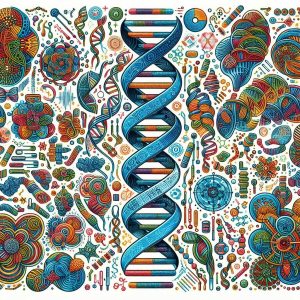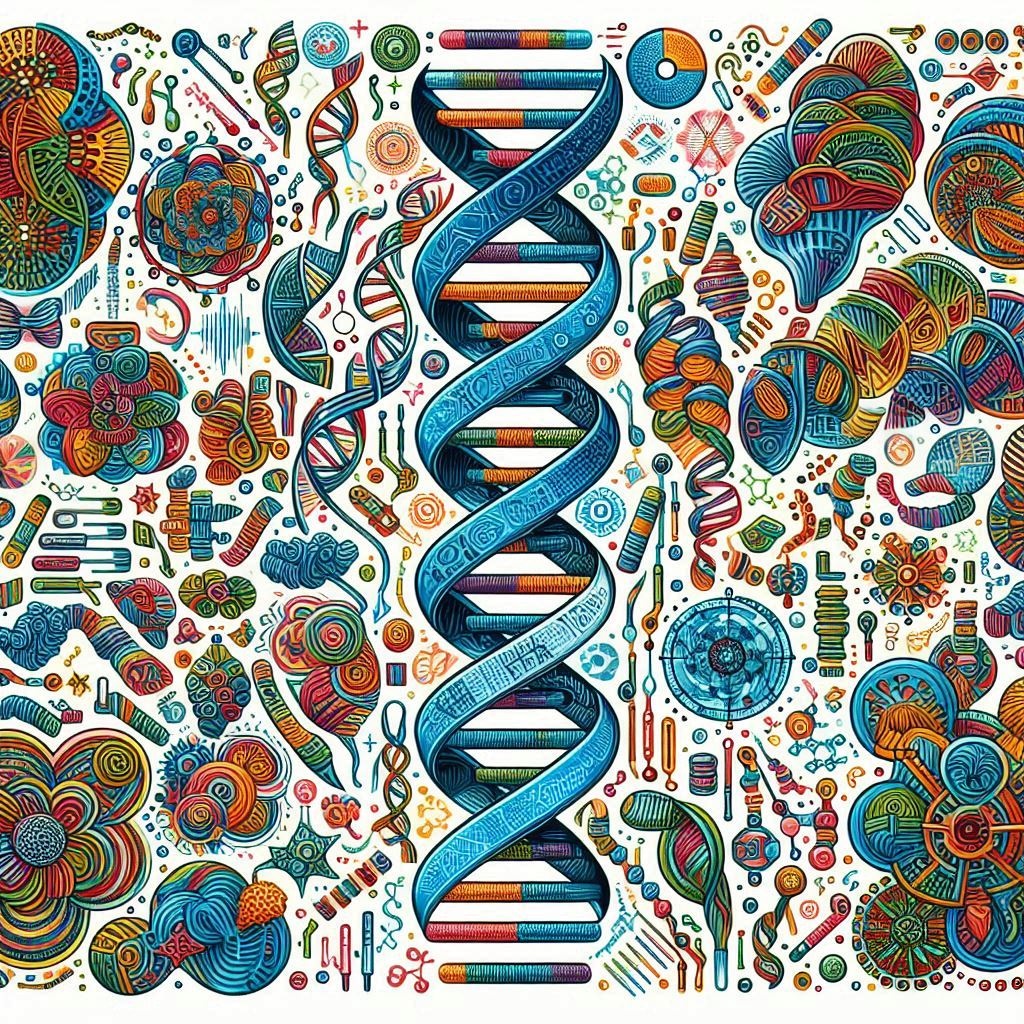Understanding the types of genes is fundamental to genetics and genomics. Genes are the basic units of heredity that carry the instructions for the growth, development, and functioning of organisms. Each type of gene plays a unique role in biological processes, and their classification helps in comprehending their diverse functions. This article explores the different types of genes, their functions, and their significance in various biological contexts.
1. Structural Genes
Structural genes are responsible for coding proteins that form the structure and function of cells. These genes are essential for producing the proteins that make up various cellular components.
- Function: They encode proteins that contribute to the physical structure of cells, tissues, and organs. Examples include genes encoding enzymes, hormones, and structural proteins.
- Examples: The collagen gene, which encodes the protein collagen, essential for connective tissues.
2. Regulatory Genes
Regulatory genes control the expression of other genes by producing regulatory proteins or RNA molecules that influence gene activity.
- Function: They regulate gene expression by turning genes on or off, or by modifying the level of gene expression. This regulation is crucial for processes such as development and cell differentiation.
- Examples: The transcription factors, which bind to specific DNA sequences to regulate the transcription of genes.
3. Operons
Operons are clusters of genes found in prokaryotes that are regulated together. They include structural genes and regulatory elements that coordinate gene expression.
- Function: Operons allow bacteria to regulate multiple genes in response to environmental changes, such as nutrient availability.
- Examples: The lac operon in E. coli, which controls the metabolism of lactose.
4. Enhancer and Silencer Genes
Enhancer and silencer genes are regulatory elements that increase or decrease the transcription of target genes, respectively.
- Enhancers: These DNA sequences enhance the transcription of associated genes. Enhancer elements can act over long distances.
- Silencers: These sequences inhibit the transcription of target genes. Silencer elements reduce gene expression by binding repressive proteins.
5. Introns and Exons
Introns and exons are components of genes in eukaryotic organisms. Exons are coding sequences that are expressed, while introns are non-coding sequences that are removed during RNA processing.
- Exons: These sequences are translated into proteins. Research on exon structure reveals their role in protein coding.
- Introns: Non-coding sequences removed during RNA splicing. Studies on intron function highlight their role in gene regulation.
6. Junk DNA
Junk DNA refers to non-coding regions of the genome that were once thought to have no function. However, research has shown that these regions may have important roles in gene regulation and genome stability.
- Function: Junk DNA may be involved in regulating gene expression and maintaining chromosomal structure. Studies suggest that it plays roles in genome organization and regulation.
- Examples: Research on non-coding RNA emphasizes the regulatory functions of these sequences.
Table: Types of Genes Overview
| Gene Type | Function | Examples |
|---|---|---|
| Structural Genes | Code for proteins that form cellular structures | Collagen |
| Regulatory Genes | Control the expression of other genes | Transcription Factors |
| Operons | Clusters of genes regulated together in prokaryotes | Lac Operon |
| Enhancer and Silencer Genes | Enhance or inhibit gene transcription | Enhancers & Silencers |
| Introns and Exons | Exons are coding sequences; Introns are non-coding sequences removed during RNA processing | Exons & Introns |
| Junk DNA | Non-coding regions that may have regulatory functions | Non-coding RNA |
Structural Genes in details
In the intricate world of genetics, structural genes hold a crucial position. These genes are responsible for coding proteins that form the structure and function of cells, tissues, and organs. Understanding structural genes is fundamental to comprehending how organisms grow, develop, and maintain their biological processes. This section delves into the specifics of structural genes, their functions, examples, and their significance in biological systems.
Function of Structural Genes
Structural genes encode proteins that are essential for the formation and maintenance of an organism’s cellular structure. These proteins include enzymes, hormones, receptors, and various structural proteins that play key roles in cellular processes.
- Enzymes: Proteins that catalyze biochemical reactions, such as amylase, which breaks down starches into sugars.
- Hormones: Regulatory proteins that coordinate physiological activities. For example, insulin regulates glucose levels in the blood.
- Receptors: Proteins that receive and transmit signals to facilitate cellular communication, like G protein-coupled receptors.
- Structural Proteins: Proteins that provide support and shape to cells and tissues. Collagen is a prime example, forming the extracellular matrix in connective tissues.
Examples of Structural Genes
Numerous structural genes have been identified, each coding for proteins with specific roles in cellular function and organismal development. Here are a few notable examples:
- Hemoglobin Gene: Encodes hemoglobin, the protein responsible for oxygen transport in red blood cells. Learn more about hemoglobin.
- Actin Gene: Codes for actin, a protein that forms microfilaments in the cytoskeleton, crucial for cell movement and structure. Read about actin.
- Keratin Gene: Produces keratin, a key structural component of hair, nails, and the outer layer of skin. More on keratin.
Table: Functions and Examples of Structural Genes
| Function | Example | Role |
|---|---|---|
| Enzyme | Amylase | Breaks down starches into sugars |
| Hormone | Insulin | Regulates blood glucose levels |
| Receptor | G Protein-Coupled Receptor | Facilitates cellular communication |
| Structural Protein | Collagen | Provides support to connective tissues |
Significance of Structural Genes
Structural genes are vital for the proper functioning and development of all living organisms. Their roles in coding for essential proteins make them fundamental to biological processes. Disruptions or mutations in structural genes can lead to various diseases and disorders, highlighting their importance in health and disease research.
- Disease Research: Structural gene mutations can cause diseases like cystic fibrosis and sickle cell anemia. More on genetic disorders.
- Biotechnology: Structural genes are manipulated in biotechnology to produce therapeutic proteins and enzymes. Learn about biotechnological applications.
In the field of genetics, regulatory genes play a pivotal role in controlling the expression of other genes. They are crucial for the proper timing, location, and amount of gene expression, ensuring that proteins are produced at the right time and in the right cells. This article explores the functions, types, and significance of regulatory genes in biological systems.
Function of Regulatory Genes
Regulatory genes encode proteins or RNA molecules that interact with other DNA sequences to increase or decrease the transcription of specific genes. These genes ensure that the correct genes are expressed in the appropriate tissues and developmental stages.
- Transcription Factors: Proteins that bind to specific DNA sequences, controlling the rate of transcription of genetic information from DNA to messenger RNA. Read more about transcription factors.
- Enhancers and Silencers: DNA sequences that can increase or decrease the activity of promoters, thus regulating gene expression. Learn about enhancers and silencers.
- RNA Interference: Small RNA molecules that can bind to messenger RNA (mRNA) and prevent its translation into protein. More on RNA interference.

Types of Regulatory Genes
Regulatory genes can be broadly categorized based on their functions and mechanisms of action. Here are a few key types:
- Activator Genes: These genes produce proteins that increase the transcription of specific target genes. Example: The lac operon in E. coli.
- Repressor Genes: Produce proteins that bind to operator sequences and inhibit transcription. Example: The trp operon in bacteria.
- Inducer Genes: Their products initiate or increase the expression of specific genes. Example: Heat shock proteins regulated by heat shock factors.
Table: Types and Functions of Regulatory Genes
| Type | Function | Example |
|---|---|---|
| Activator Genes | Increase transcription of target genes | Lac Operon |
| Repressor Genes | Inhibit transcription of target genes | Trp Operon |
| Inducer Genes | Initiate or increase gene expression | Heat Shock Factors |
Significance of Regulatory Genes
Regulatory genes are vital for the proper functioning of cellular processes. They play a crucial role in development, differentiation, and response to environmental changes. Here are a few reasons why regulatory genes are important:
- Developmental Processes: Regulatory genes ensure that genes are expressed in the right cells at the right times during development. Disruptions can lead to developmental disorders. More on developmental biology.
- Cell Differentiation: They control the process by which a cell becomes specialized to perform a specific function. Learn about cell differentiation.
- Response to Environmental Signals: Regulatory genes help organisms adapt to changes in their environment by altering gene expression patterns. Read about environmental adaptation.
In the field of genetics and molecular biology, operons are a fundamental concept that explains how genes are regulated and expressed in prokaryotic organisms. Operons are clusters of genes that are controlled by a single promoter and are transcribed together as a unit. This mechanism allows for coordinated regulation of genes that function in the same pathway, ensuring efficient cellular responses to environmental changes. This article delves into the structure, function, types, and significance of operons, with a focus on well-known examples like the lac operon.
Structure of Operons
An operon typically consists of several components that work together to regulate gene expression:
- Promoter: A DNA sequence where RNA polymerase binds to initiate transcription.
- Operator: A segment of DNA that acts as a binding site for repressor proteins, which can block transcription.
- Structural Genes: Genes that are transcribed together into a single mRNA molecule and code for related proteins.
- Regulatory Genes: Genes that produce repressor or activator proteins influencing the operon’s activity.
Function of Operons
Operons play a crucial role in the regulation of gene expression in prokaryotes. By grouping genes with related functions into a single operon, cells can efficiently coordinate the production of proteins in response to environmental changes. The regulation of operons typically involves repressor proteins that can bind to the operator region to inhibit transcription or activator proteins that enhance transcription.
Types of Operons
Operons can be classified based on their regulatory mechanisms:
- Inducible Operons: These operons are usually off but can be turned on in the presence of a specific inducer molecule. The lac operon is a classic example, which is activated in the presence of lactose.
- Repressible Operons: These operons are usually on but can be turned off when a specific corepressor molecule is present. The trp operon is a well-known example, which is inhibited by high levels of tryptophan.
Table: Comparison of Inducible and Repressible Operons
| Feature | Inducible Operons | Repressible Operons |
|---|---|---|
| State in Absence of Effector Molecule | Off | On |
| Example | lac Operon | trp Operon |
| Regulatory Mechanism | Inducer Molecule | Corepressor Molecule |
| Example of Effector Molecule | Lactose | Tryptophan |
Significance of Operons
Operons are critical for the efficient regulation of gene expression in prokaryotes. They allow bacteria to quickly adapt to environmental changes by turning groups of genes on or off in response to specific signals. This coordinated regulation is essential for processes like metabolism, response to stress, and pathogenesis.
Example: The Lac Operon
The lac operon in Escherichia coli is one of the most studied examples of gene regulation. It controls the metabolism of lactose in the bacterium. In the absence of lactose, a repressor protein binds to the operator region, preventing transcription. When lactose is present, it binds to the repressor, causing it to release from the operator and allowing transcription to proceed.
Conclusion
Structural genes are indispensable for the biological processes that sustain life. Their roles in encoding essential proteins underscore their importance in both health and disease. Ongoing research into structural genes continues to reveal their complexities and applications, making them a critical focus in the fields of genetics and biotechnology.
Operons are a fundamental aspect of gene regulation in prokaryotes, providing a mechanism for the coordinated expression of related genes. By understanding operons, scientists can gain insights into the complex regulatory networks that control cellular functions and responses to environmental changes.
For further reading, visit these resources:
- NCBI: Operons and Gene Regulation
- Khan Academy: The Lac Operon
- Nature: Gene Expression and Regulation
FAQs
How many types of genes?
Genes can be classified into several types based on their functions and characteristics. The primary categories include:
- Structural Genes: These genes code for proteins that form the physical structure of an organism, such as enzymes, hormones, and structural proteins. They play a crucial role in the growth, development, and maintenance of an organism’s body.
- Regulatory Genes: These genes control the expression of other genes. They are involved in regulating the timing, location, and amount of gene expression, thus playing a vital role in cellular function and development.
- Housekeeping Genes: These are essential genes that are expressed in all cells of an organism. They are responsible for maintaining basic cellular functions necessary for the survival of the cell, such as metabolism, DNA replication, and protein synthesis.
- Oncogenes: These genes have the potential to cause cancer. When mutated or expressed at high levels, oncogenes can promote uncontrolled cell division, leading to tumor formation.
- Tumor Suppressor Genes: These genes help prevent cancer by inhibiting cell division, repairing DNA damage, or initiating cell death (apoptosis) in damaged cells. Mutations in these genes can lead to cancer development.
- Homeotic Genes: These genes determine the basic structure and orientation of an organism during embryonic development. They are responsible for the correct placement of body parts.
- Pseudogenes: These are non-functional segments of DNA that resemble functional genes. They may arise from gene duplication or mutations and do not produce functional proteins.

How do structural genes differ from regulatory genes?
Structural genes code for proteins that perform essential cellular functions, while regulatory genes control the expression of other genes, thereby regulating various biological processes.
What is an operon?
An operon is a cluster of genes that are transcribed together as a single mRNA molecule and regulated by a common promoter. Operons are typically found in prokaryotes and help coordinate the expression of genes with related functions.
Why are housekeeping genes important?
Housekeeping genes are crucial because they are responsible for the maintenance of basic cellular functions necessary for cell survival. These genes are expressed in all cells of an organism.
What role do regulatory genes play in development?
Regulatory genes play a key role in development by controlling the expression of other genes in a precise manner. They ensure that genes are turned on or off at the right times and in the right cells during development.
What are the most common types of genes studied?
The most commonly studied genes include structural genes, which code for proteins, and regulatory genes, which control gene expression. In the context of medical research, oncogenes and tumor suppressor genes are also of significant interest due to their roles in cancer development and prevention.
Can genes belong to more than one category?
Yes, some genes can play multiple roles and belong to more than one category. For example, a gene might function as both a regulatory gene and a structural gene, depending on the context and the specific proteins it interacts with or produces.
Disclaimers and Cautions about Types of Genes
Disclaimers
The information provided in this article on “Types of Genes” is intended for educational purposes only. It aims to offer a general understanding of genetic concepts and should not be used as a substitute for professional medical advice, diagnosis, or treatment. While efforts have been made to ensure the accuracy of the content, genetic science is a rapidly evolving field, and new discoveries can impact our understanding of genetics and related subjects.
Cautions
Consultation with Healthcare Professionals: For specific medical or genetic concerns, always seek the advice of qualified healthcare professionals or genetic counselors. They can provide personalized guidance based on individual health conditions and genetic backgrounds.
Understanding Limitations: This article discusses general categories of genes and their functions. However, the expression and impact of genes can vary widely among individuals due to complex interactions with other genes and environmental factors. Readers should be aware of these complexities and the limitations of current genetic knowledge.
Ethical Considerations: The study and application of genetics raise important ethical and privacy concerns. Genetic information is sensitive and personal, and it should be handled with care and respect for individuals’ privacy and autonomy. Readers are encouraged to consider these ethical aspects and adhere to best practices when engaging with genetic information.
Continual Learning: As genetics is a constantly advancing field, the information in this article may become outdated as new research and technologies emerge. Readers are advised to stay informed by consulting up-to-date, reputable sources and scientific literature.
Caution in Interpretation: Genetic information can be complex and may require expert interpretation. Caution should be exercised in drawing conclusions or making decisions based solely on general information. Professional consultation is recommended for interpreting genetic data and understanding its implications.
By reading this article, you acknowledge that you understand these disclaimers and cautions. The authors and publishers are not responsible for any consequences arising from the use of the information provided herein.
I mentioned again that, the information provided in this article is for educational purposes only and is not intended as a substitute for professional advice or scientific research.



